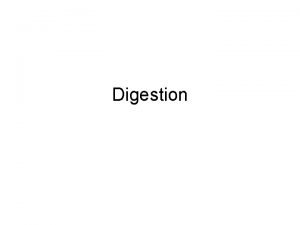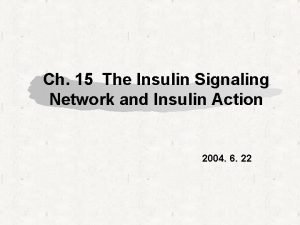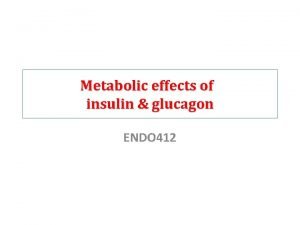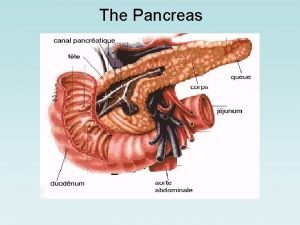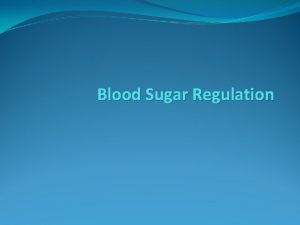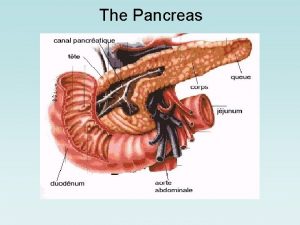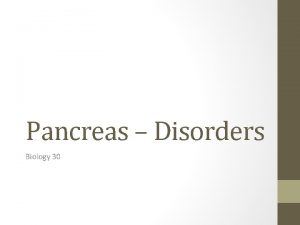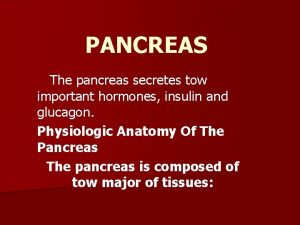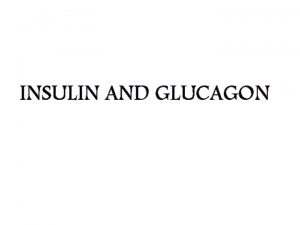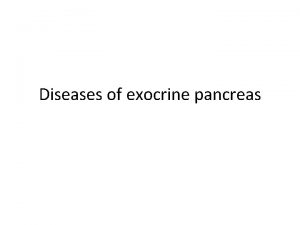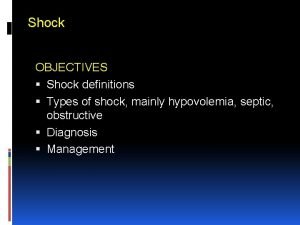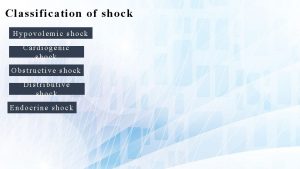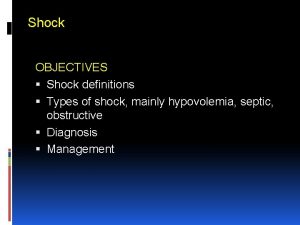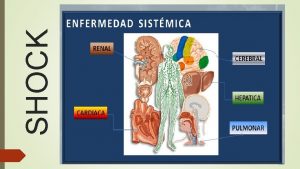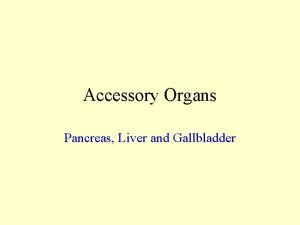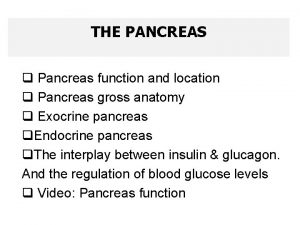DISEASES OF THE PANCREAS INSULIN SHOCK Insulin Shock









































- Slides: 41

DISEASES OF THE PANCREAS INSULIN SHOCK

Insulin Shock Causes: 1. Insulin overdose (misread syringe) 2. Too much exercise 3. Anorexia Signs: Weakness, incoordination, seizures, coma

Insulin Shock Prevention 1. Consistent diet (type and amount)/consistent exercise (less insulin with exercise) 2. Monitor urine/blood glucose at same time each day 3. Feed 1/3 with insulin; the rest 8 -10 h later (at insulin peak) 4. Have sugar supply handy

Insulinoma CAUSE: tumor of beta cells, secreting an excess of insulin SIGNS: prolonged hypoglycemia→weakness, ataxia, muscle fasciculations, posterior paresis, brain damage, seizures, coma, death,

Insulinoma: Dx Chem Panel ↓blood glucose Simultaneous glucose and insulin tests Low glucose, High insulin => insulinoma Observations of Whipple’s Triad: Symptoms occur after fasting or exercise when symptomatic, blood glucose<50 mg/dl symptoms corrected with sugar administration

Insulinoma: Rx Surgical Rx: removal of tumor Medical Rx: Acute, at home: administer glucose (Karo); keep animal quiet, seek vet care Acute, in Hosp adm. glucose (50% Dextrose) Chronic care feed 3 -6 small meals/day (high protein, low fat) limited exercise glucocorticooid therapy (antagonizes insulin effect at cellular level) Diazoxide (↓insulin secretion, tissue use of glucose, ↑blood glucose) Octreotide (Sandostatin) injections—inhibits synthesis and release of insulin by both normal and neoplastic beta cells

Insulinoma: Client info 1. Usually, by the time insulinoma is diagnosed, metastasis has occurred so prognosis is poor 2. With proper medical therapy, survival may be 12 -24 mo 3. Always limit exercise and excitement 4. Feed multiple, small meals throughout day; keep sugar source close during exercise 5. Karo syrup on mm provides for rapid absorption of glucose into blood stream 6. Avoid placing hand into dog’s mouth during seizure to avoid being bitten

Diseases of the exocrine pancreas EXOCRINE PANCREATIC INSUFFICIENCY

Exocrine Pancreas Insufficiency (EPI) Inability to process nutrients efficiently due to lack of production of enzymes from pancreas. Pancreatic acinar atrophy Found most commonly in German Shepherds and Rough Collies through a recessive gene. In cats, EPI is primarily the result of chronic pancreatitis

Diagnosis of EPI Not usually evident until 85 -90% of pancreas is unable to secrete enzymes. Weight loss although no change in diet or appetite (appetite often increases) Persistent tarry diarrhea. Flatulence Poor haircoat

Testing and treatment for EPI TLI (trypsin-like immunoreactivity) Detects trypsin and trypsinogen Usually want below 2. 5 in dogs to be diagnostic Canine 5. 7 -45. 2 Feline 12 -82 Treatment includes enzymatic supplement Viokase powder Raw ox or pig pancreas

Client considerations Usually life long treatment. Can be very expensive. Can be well controlled. Should not breed animal that has EPI.

DISEASES OF THE ADRENAL GLANDS CUSHING’S DISEASE (HY PER AD RENOCOR TICISM) ADDISON’S DISEASE (H YP OADRENOCOR TICISM)

Adrenal Glands

ADRENAL GLANDS mineralocorticoids Glucocorticoids Androgens epinephrine

Physiology Hypothalamus – Corticotropin realeasing factor (CRF) > Anterior Pituitary Gland – Adrenocorticotropic hormone (ACTH) > ADRENAL CORTEX Glucocorticoid hormone Mineralocorticoid hormone Sex hormones (Androgens) Sympathetic Nerv Sys > ADRENAL MEDULLA > Epinehrine and norepinephrine Increase HR, Inc. BP, Dilated air passages – lungs, dec. GI function, vasoconstriction

Hormone Functions Mineralocorticoids – Aldosterone • • Regulates electrolyte and H 2 O balance Hypoadrenocorticism/ Addison’s Primarily Dogs Life threatening Glucocorticoids • • • Promote gluconeogenesis Suppress inflammation Suppress immune system Inhibit cartilage growth and development Hyperadrenocorticism / Cushing’s

Hyperadrenocorticism (Cushing’s Disease) Definition: Disorder caused by deleterious effects of high circulating cortisol concentrations on multiple organ systems Systems affected: Renal Skin Cardiovascular Respiratory Endocrine/metabolic Musculoskeletal Nervous Reproductive

Cushing’s Disease Effects of excess glucocorticoids: suppress inflammation 2. suppress immune system 3. inhibit cartilage growth, development, and repair Causes: 1. 2. 3. Anterior pituitary lesion (pituitary-dependent disease) – 85% of cases Adrenal tumor (excess cortisol secretion independent of pituitary control) – 15 -20% of cases Overmedication with glucocorticoids - Iatrogenic

Cushing’s Disease

Cushing’s Disease Bilaterally symmetrical alopecia, pot-belly, pyoderma

Cushing’s Disease Pot bellied PU/PD Muscle wasting Thin coat

Cushing’s Disease signs are slow to develop and usually go unnoticed by owner Clinical Signs: 1. Some are similar to hypothyroidism 2. Dog >6 yr old (most are female) 3. PU/PD/PP 4. Pot bellied; obese 5. Muscle atrophy and weakness, lethargy, excess panting 6. Bilateral symmetric alopecia; pruritis; pyoderma (↓ immune response) 7. Calcinosis cutis (firm plaques of Ca++ under skin) 8. Abnormal gonadal function (lack of estrus; soft, small testicles)

Cushing’s Disease: Calcinosis cutis Commonly seen on the dorsal midline, ventral abdomen and inguinal region. Skin is usually thin and atrophic

Cushing’s Disease: Dx Chemistry Panel 1. 2. 3. 4. ↑ ALP, ALT, cholesterol, blood glucose ↓ BUN Lipemia Low USG < 1. 015, proteinuria, hematuria, pyuria, bactiuria Urine cortisol/creatinine ratios (sample collected at home) 1. 2. Normal ratio=no Cushing’s Elevated ratio=may be Cushing’s ACTH Stimulation test 1. 2. 3. Normal patients show an increase of plasma cortisol Pituitary dependent disease (excess ACTH release) and Adrenal tumors: 60 -85% show EXAGGERATED cortisol response Does not differentiate between Pit disease and Adrenal tumor

ACTH Stimulation for Hyperadrenocorticism Take a pre blood sample. Inject ACTH stimulation gel or liquid Verify amounts with lab as there is difference between amount to be injected with gel and liquid. Wait two hours and take a post sample

Cushing’s Disease: Dx Low-Dose Dexamethasone Suppression Test 1. 2. Inject low dose of steroid (should suppress ant. pit [ACTH]) Measure plasma cortisol at 0, 4, 8 h Interpretation: 1. 2. Normal dogs will show decrease in plasma cortisol Pituitary tumor and adrenal tumor will not show any effect at 8 h (cortisol will still be high)

Cushing’s Disease: Dx High-Dose Dexamethasone Suppression Test (used to differentiate between Pit Dis and Adrenal tumor) 1. Collect plasma cortisol at 0, 4, and 8 h Interpretation: 1. 2. Pituitary dependent disease— 70 -75% will show decrease at 4 or 8 h Adrenal tumor—no change in plasma cortisol level (tumor is autonomous)

Cushing’s Disease: Rx Surgical removal— 1. 2. FAT - Specialized surgery; most vets would refer surgery Pituitary tumors are not surgically removed Medical treatment 1. Lysodren (o, p, DDD)—necrosis of z fasiculata (middle), z reticularis (deep) -repeat ACTH stimulation q 7 -10 d until cortisol normal -like chemotherapy -excess dose affects z glomerulus (Addison’s Dis)

Cushing’s Disease: Rx 2. trilostane (Vetoryl®)—less side-effects than o, p, DDD -interfers with cortisol production (doesn’t kill cells) -FDA approved

Cushing’s Disease: Client info Serious disease; life-long treatment Periodic monitoring required Addison’s disease may result Prognosis: average life expectancy is 20 -30 mo on therapy with frequent recurrence of clinical symptoms – varies with cause (pit vs adrenal, tumors)

Addison’s Disease (Hypoadrenocorticism) Definition: Disorder caused by deficient production of glucocorticoids (cortisol) or mineralocorticoids (aldosterone) or both Secondary disease caused by chronic administration of corticosteroids followed by sudden cessation

Addison’s Disease (Hypoadrenocorticism) Clinical Signs: 1. 2. 3. 4. lethargy, weakness, anorexia, wt loss Vomiting/Diarrhea PU/PD, dehydration Bradycardia

Addison’s Disease Pathophysiology Decreased aldosterone => Increased K and decreased Na=> decreased volume => azotemia, hypotension, dehydration, weakness, depression Hyper K => heart (bradycardia) Glucocorticoid deficiency => vomiting, diarrhea, melena, lethargy, wt loss, hypoglycemia (less common than expected)

Addison’s Disease: Dx Chem Panel Na: K ratio <25: 1!(normal=27: 1 to 40: 1) ↑ BUN, Creatinine, Ca++ ↓ blood glucose, albumin (less common ACTH Stimulation test (definitive test) normal dog= ↑ cortisol hypoadrenocorticism dog= low, unchanged cortisol level Endogenous ACTH will be increased (1º hypoadrenocorticism; lack of neg feedback)

What is your Dx? Chem Panel Parameter BUN Creatinine Sodium Potassium Na: K ratio (What is not normal? ) Value 81 mg/dl 2. 1 mg/dl 131 meq/L 6. 5 meq/L 20 Normal value 7 -27 mg/dl 0. 4 -1. 8 mg/dl 141 -156 meq/L 4. 0 -5. 6 meq/L 27 -40

What is your Dx? ACTH Stimulation Test Results Value Normal Plasma Cortisol Pre-ACTH Post-ACTH 0. 2 0. 3 2 -6 6 -18

Addison’s Disease Tx Acute Crisis (may be life-threatening situation) Normal saline IV (low Na+ is hallmark finding of Addison’s) Glucorticoid replacement(cortisol will also be low) 1. 2. Dexamethasone or Prednisone (IV or IM) a. Mineralocorcorticoid replacement 3. a. b. Florinef® (fludrocortisone acetate)—po Percortin-V (desoxycorticosterone pivalate) injection

Addison’s disease TX Chronic Management Glucocorticoid replacement 1. a. b. Mineralocorcorticoid replacement 2. a. b. 3. Prednisone Prenisolone Florinef® (fludrocortisone acetate)—po daily (not cheap; 50¢/tab) Percortin-V (desoxycorticosterone pivalate)—inj ~monthly (expensive) Monitor electrolytes, BUN/Creatinine, clinical signs

Addison’s disease: Client info 1. 2. 3. 4. 5. 6. Mineralocorticoid deficiency is life-threatening Animal requires periodic blood tests Glucocorticoids needed in times of stress Always remind attending vet of pet’s condition Hormone replacement therapy continued for life of pet Prognosis: Good to excellent after stabilization and treatment

References Alleice Summers, Common Diseases of Companion Animals http: //www. aahanet. org/Public. Documents/AAHAD iabetes. Guidelines. pdf http: //www. vetmed. wsu. edu/cliented/diabetes. aspx http: //www. sciencedirect. com/science/article/pii/S 0378427408001732
 Pancreas produces insulin
Pancreas produces insulin Insulin and insulin receptor
Insulin and insulin receptor Insulin effect on carbohydrate metabolism
Insulin effect on carbohydrate metabolism Emergency drugs
Emergency drugs Insulin shock medical definition
Insulin shock medical definition Spinal shock vs neurogenic shock
Spinal shock vs neurogenic shock Subacute combined degeneration of the cord
Subacute combined degeneration of the cord Shock normovolemico
Shock normovolemico Spinal shock vs neurogenic shock
Spinal shock vs neurogenic shock T10 spinal cord
T10 spinal cord Thế nào là mạng điện lắp đặt kiểu nổi
Thế nào là mạng điện lắp đặt kiểu nổi Dot
Dot Bổ thể
Bổ thể Vẽ hình chiếu đứng bằng cạnh của vật thể
Vẽ hình chiếu đứng bằng cạnh của vật thể độ dài liên kết
độ dài liên kết Các môn thể thao bắt đầu bằng từ đua
Các môn thể thao bắt đầu bằng từ đua Khi nào hổ mẹ dạy hổ con săn mồi
Khi nào hổ mẹ dạy hổ con săn mồi điện thế nghỉ
điện thế nghỉ Một số thể thơ truyền thống
Một số thể thơ truyền thống Nguyên nhân của sự mỏi cơ sinh 8
Nguyên nhân của sự mỏi cơ sinh 8 Trời xanh đây là của chúng ta thể thơ
Trời xanh đây là của chúng ta thể thơ Số nguyên tố là gì
Số nguyên tố là gì Thiếu nhi thế giới liên hoan
Thiếu nhi thế giới liên hoan Tỉ lệ cơ thể trẻ em
Tỉ lệ cơ thể trẻ em Phối cảnh
Phối cảnh Các châu lục và đại dương trên thế giới
Các châu lục và đại dương trên thế giới Thế nào là hệ số cao nhất
Thế nào là hệ số cao nhất Hệ hô hấp
Hệ hô hấp Tư thế ngồi viết
Tư thế ngồi viết Bàn tay mà dây bẩn
Bàn tay mà dây bẩn Hát kết hợp bộ gõ cơ thể
Hát kết hợp bộ gõ cơ thể đặc điểm cơ thể của người tối cổ
đặc điểm cơ thể của người tối cổ Mật thư anh em như thể tay chân
Mật thư anh em như thể tay chân Tư thế worm breton là gì
Tư thế worm breton là gì Tư thế ngồi viết
Tư thế ngồi viết ưu thế lai là gì
ưu thế lai là gì Chó sói
Chó sói Thẻ vin
Thẻ vin Thể thơ truyền thống
Thể thơ truyền thống Các châu lục và đại dương trên thế giới
Các châu lục và đại dương trên thế giới Từ ngữ thể hiện lòng nhân hậu
Từ ngữ thể hiện lòng nhân hậu Diễn thế sinh thái là
Diễn thế sinh thái là
